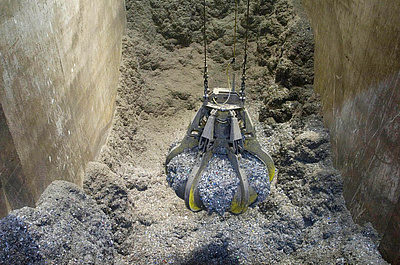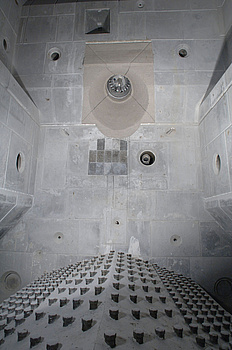Waste-to-Energy

Delivery of waste
Solid waste
Trucks drive into the roofed dumping store. They deliver the solid waste in bulk. These waste products are too big to be fed directly into the furnace and are first treated in a pre-treatment installation.
Two identical production lines each with 2 shredders and 2 overhead magnets reduce and de-iron the delivered waste. Afterwards the material ends up on a communal conveyor belt, where it will be de-ironed again before it is transported to the waste bunker.
The pre-treated waste streams are unloaded directly into one of the six tipping apertures next to the waste bunker. The waste is taken to one of the three feed chutes using a grab crane. Large twin screws and a chain conveyor system feed the waste into the furnace.
Sludge
Trucks dump the sludge into one of the three sludge bunkers. A semi-automatic crane is used for mixing and feeding the sludge silo, from where the sludge is pumped into the furnaces.

Combined thermal processing
Each furnace is equipped with 2 feed screws that dose the solid waste from the feeding chute onto the fluidised bed. The sludge is pumped into the furnace in an even and controlled manner.
The incineration process takes place at a temperature of minimum 850 °C. At the bottom of the furnace there is a sand bed. Air nozzles blow air into the sand bed at high speed from below. This primary air thrusts the sand bed upwards into the oven, making it swirl like a fluid. The waste is introduced via two overhead openings directly into the hot sand. It mixes in with the sand and burns instantly. The sludge is fed into the furnace via the 4 side walls. Secondary air is blown into the furnace above the sand bed. This secondary air ensures optimum incineration.
Ammonia water is injected directly into the furnace to achieve the necessary NOx emissions limit.
Screws remove the sand and bottom ash from the furnace. Once it has been sieved the sand fraction is recovered and subsequently brought back into the fluidised bed. A magnet separates the metals from the bottom ash.

Thorough flue gas cleaning
The flue gases are purified intensively in successive installations to meet the strict emission standards.
- Electro filters remove the fly ashes.
- Raw materials such as lime and an adsorbent are injected into the Circoclean reactor for maximum removal of the acidic components (such as chloride and sulphur), heavy metals and dioxins.
- The baghouse filters separate the solid components in the form of flue gas purification residues. These residues are first solidified and then dumped into a Category 1 landfill.
- The final step in the cleaning of the flue gases is the removal of the rest of the chloride and sulphur components by means of wet washing with sodium hydroxide.
Continuous monitoring of the emissions by an emissions laboratory located at the chimneys, guarantees that the purified flue gases that leave the chimneys comply with the strictest environmental standards.

Energy recovery
Rational energy management was the focal-point in designing the fluidised bed installation. The furnaces are therefore built to recover energy efficiently.
The heat generated from the thermal treatment is recovered in a vertical steam boiler. The steam boiler consists of a network of water channels. The heat from the flue gases turns the water into high-pressure steam. Turbines convert the steam produced into electricity. If all of the energy that SLECO recovers from thermal treatment was converted into electricity, we would be able to supply around 100,000 households with energy each year.
The electricity is supplied to the high-voltage network, and the residual steam is supplied directly to the ECLUSE network for use by the businesses in the Waasland Port for their chemical processes.
Waste-to-materials: recovery of valuable raw materials
- Pre-treatment in the fluidised bed incinerators removes the metal fraction from most of the delivered waste. This scrap fraction is cleaned in the pre-treatment unit for highly calorific waste in order to reuse it.
- While thermally treating waste, we aim to recover as many materials as possible. We do this by means of an ash treatment. Using separation processes, we purify and sort the bottom ashes into reusable materials in the ash treatment plant.
